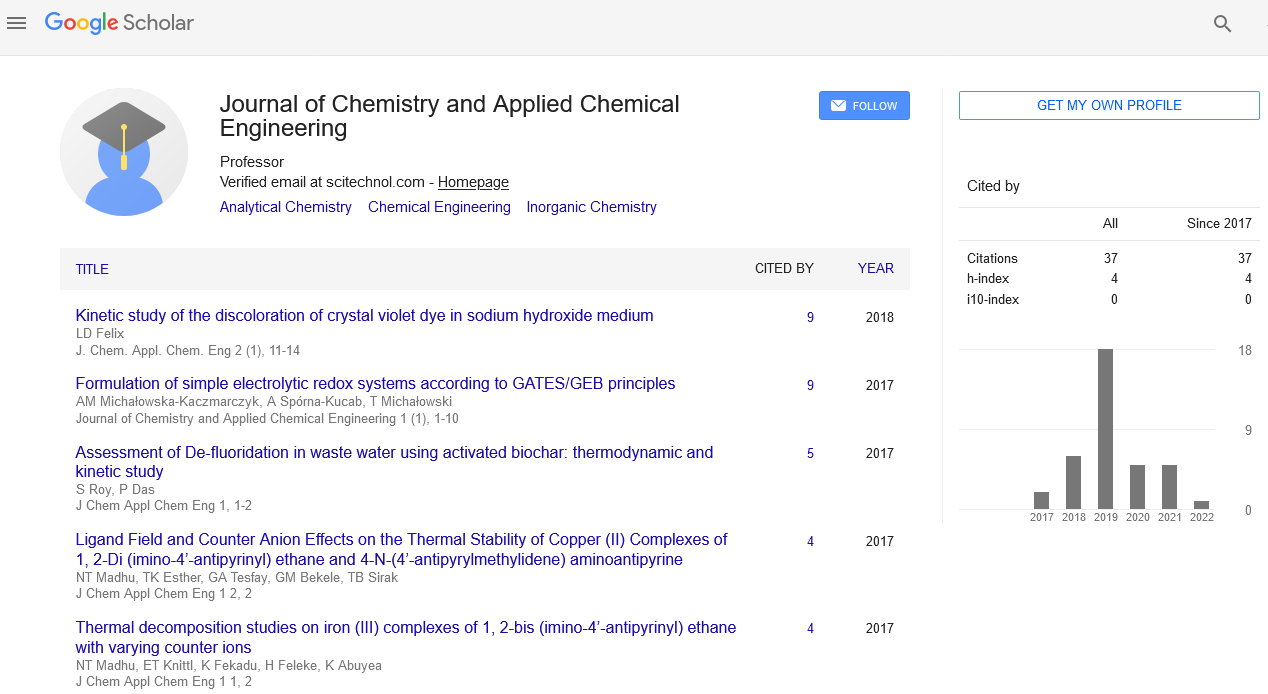Catalytic oxidation of β-O-4-bonded model compounds using Keggin-type POMs towards lignin aromatic moieties valorization
Juan Diaz S, David Contreras P.*
Universidad de Concepción, Chile
: J Chem Appl Chem Eng
Abstract
Lignocellulosic biomass is a renewable, biodegradable and readily available resource. In recent years, research focused on the exploitation of this resource has gained momentum as a raw material for obtaining clean energy and valueadded chemical products. Lignin represents the only renewable source of aromatic chemicals and the second renewable source of carbon. Therefore, the direct and efficient conversion of lignin into discrete molecules, low molar aromatic compounds or monomeric platform molecules for polymer production is a great challenge and an interesting opportunity for the future. In the present work a series of tetrabutyl ammonium (TBA) salts of V-included Keggin-type polyoxoanions with W (TBA4PW- 11V1O40 and TBA5PW10V2O40) and Mo (TBA4PMo11V1O40 and TBA5PMo10V2O40) as addenda atoms were prepared using a hydrothermal method. These synthesized materials were haracterized by X-ray diffraction (XRD), Fourier transform infrared spectroscopy (FT-IR), UV-Vis diffuse reflectance (DRS UV-Vis), thermogravimetric analysis (TGA), CHN elemental analysis (EA), inductively coupled plasma spectrometry (ICP-MS) and N2 physisorption techniques to assess their physicochemical/ textural properties and correlate them with their catalytic performances. According to FT-IR and DRS UV-Vis, (PVxW(Mo)12-xO40) (3+x)-anions are the main species present in the TBA salts. Additionally, CHN-EA and ICP-MS revealed that the desired stoichiometry was obtained. Their catalytic activities in the liquid-phase and aerobic oxidation of benzyl alcohol to benzaldehyde were studied at 5 bar of O2 and 170°C. Independently of the addenda atom nature the catalytic activity increased with the number of V in Keggin anion structure. For both series of catalysts, TBA salts of polyoxometalates with the highest V-substitution degree (TBA5PMo10V2O40 and TBA5PW10V2O40) showed the higher activity. The maximum benzyl alcohol acronym UdeC, is a traditional Chilean university, one of the most traditional and prestigious in the country, considered complex for its research extension in various areas of knowledge. Founded on May 14, 1919, it is the third oldest university in Chile, and one of the 30 universities belonging to the Council of Rectors of Chilean Universities. Its main campus is located in the city of Concepción, and it also has two other campuses in the cities of Chillan in the Ñuble Region and Los Angeles, Biobío Region. It also has a presence in the capital of Chile with its Santiago Unit in the Providencia district. In 2012.
Biography
I am a Chemist and bachelor’s in chemistry from University of Chile. Nowadays, i’m a 4th-year student in the program Ph.D. in Sciences, Mention in Chemistry, at the University of Concepción. My PhD is supported by a national grant and recently obtained competitive national funding in doctoral thesis in productive sector national program (ANID-PAI) supported by UdeC-CIPA joint. The scientific production during these years were 6 scientific peer-reviewed articles (ISI) and 12 conferences. Because my interest in green chemistry and chemistry of materials.
 Spanish
Spanish  Chinese
Chinese  Russian
Russian  German
German  French
French  Japanese
Japanese  Portuguese
Portuguese  Hindi
Hindi 